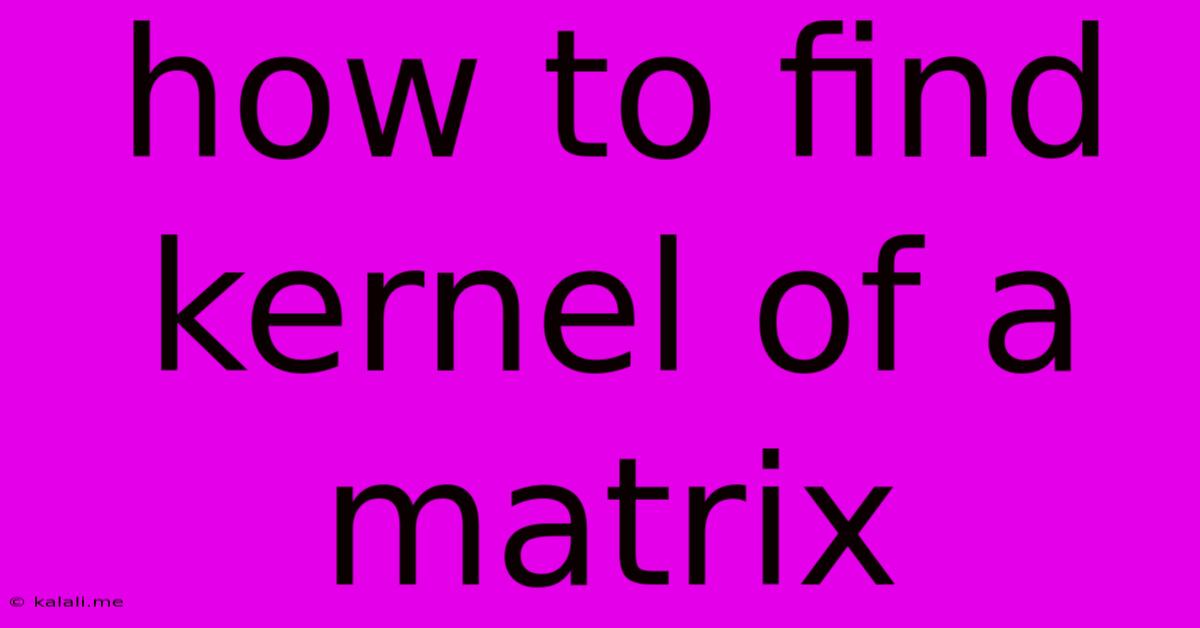How To Find Kernel Of A Matrix
Kalali
May 29, 2025 · 3 min read

Table of Contents
How to Find the Kernel of a Matrix: A Comprehensive Guide
Finding the kernel of a matrix is a fundamental concept in linear algebra with applications in various fields like computer science, machine learning, and physics. This guide will walk you through the process, explaining the underlying concepts and providing practical examples. Understanding the kernel helps you grasp the null space of a linear transformation and solve systems of linear equations.
The kernel (or null space) of a matrix A is the set of all vectors x such that Ax = 0. In simpler terms, it's the set of all vectors that, when multiplied by the matrix A, result in the zero vector. Finding the kernel involves solving a system of homogeneous linear equations.
Understanding the Process
The process of finding the kernel involves several steps:
-
Set up the augmented matrix: Begin by constructing the augmented matrix [A|0], where A is your matrix and 0 is the zero vector with the same number of rows as A.
-
Perform Gaussian elimination (row reduction): This is the core of the process. Use elementary row operations (swapping rows, multiplying a row by a non-zero scalar, adding a multiple of one row to another) to transform the augmented matrix into row echelon form or, preferably, reduced row echelon form. This simplifies the system of equations.
-
Identify free and leading variables: Once in row echelon form, identify the leading variables (variables corresponding to pivot columns) and free variables (variables without corresponding pivot columns).
-
Express leading variables in terms of free variables: Solve the system of equations for the leading variables in terms of the free variables.
-
Write the general solution: The general solution will express each variable as a linear combination of the free variables. This solution represents all vectors in the kernel.
-
Express the kernel as a span of vectors: Finally, rewrite the general solution as a linear combination of vectors. Each vector corresponds to a free variable, and the coefficients are the free variables themselves. This gives you the kernel expressed as a span of linearly independent vectors which form a basis for the kernel.
Example: Finding the Kernel of a 3x3 Matrix
Let's find the kernel of the following matrix:
A = [ 1 2 3 ]
[ 0 1 1 ]
[ 1 0 2 ]
- Augmented Matrix: [A|0] becomes:
[ 1 2 3 | 0 ]
[ 0 1 1 | 0 ]
[ 1 0 2 | 0 ]
- Row Reduction: Performing Gaussian elimination, we might obtain (steps omitted for brevity, but you'd use row operations):
[ 1 0 1 | 0 ]
[ 0 1 1 | 0 ]
[ 0 0 0 | 0 ]
-
Variables: Here, x₁ and x₂ are leading variables, and x₃ is a free variable.
-
Expressing Leading Variables: From the reduced matrix, we get:
- x₁ = -x₃
- x₂ = -x₃
- General Solution: The general solution is:
- x₁ = -t
- x₂ = -t
- x₃ = t (where 't' is any scalar)
- Kernel as a Span: We can rewrite this as:
x = t[-1, -1, 1]
Therefore, the kernel of matrix A is the span of the vector [-1, -1, 1]. This means any scalar multiple of this vector will be in the kernel of A.
Conclusion
Finding the kernel of a matrix is a crucial process in linear algebra. By systematically applying Gaussian elimination and understanding the concepts of leading and free variables, you can efficiently determine the null space and gain valuable insights into the properties of the linear transformation represented by the matrix. Remember to practice with various examples to solidify your understanding. This skill is essential for tackling more complex problems in linear algebra and its numerous applications.
Latest Posts
Latest Posts
-
How To Get Stone Bricks In Minecraft
May 30, 2025
-
Wire Size For 125 Amp Breaker
May 30, 2025
-
Getting Warm In A Sunny Window
May 30, 2025
-
My Min Plant Wont Stand Upright
May 30, 2025
-
How Do You Say Welcome Back In Spanish
May 30, 2025
Related Post
Thank you for visiting our website which covers about How To Find Kernel Of A Matrix . We hope the information provided has been useful to you. Feel free to contact us if you have any questions or need further assistance. See you next time and don't miss to bookmark.